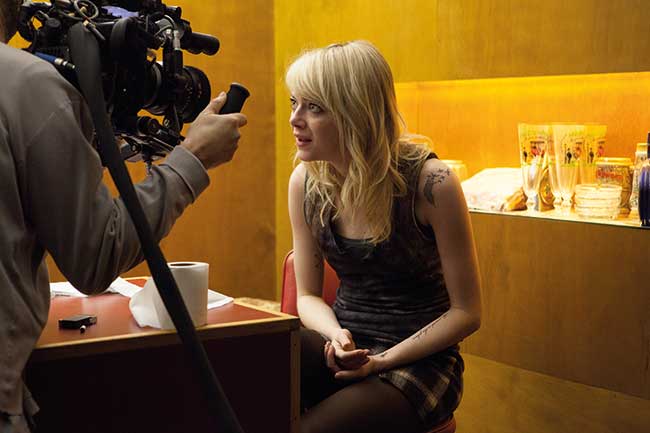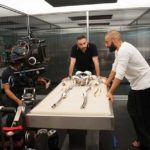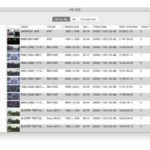
Bird Men
Posted on Mar 2, 2015 by Alex Fice
Michael Keaton as “Riggan” on the set of BIRDMAN. Photo courtesy of Fox Searchlight Pictures.
DoP Emmanuel Lubezki initially didn’t want to shoot BIRDMAN mainly because he had recently shot GRAVITY with it’s meticulous long takes. He quickly realised that this new movie was out of the comfort zone of the director as well, in fact Alejandro González Iñárritu ideally wanted one take!
After spending two years on the meticulous production of GRAVITY, Oscar-winning cinematographer Emmanuel Lubezki ASC, AMC was looking forward to his first feature collaboration with director Alejandro González Iñárritu. The script for BIRDMAN initially was not what the DP wanted in his next film. “When I read BIRDMAN, I was a bit in shock because it had all of the elements of a movie that I did not want to do at all. It was mostly in studio, and I didn’t want to work in studio. It was a comedy, and I did not want to do comedy. It was a movie that he wanted to do in very long takes – probably in one shot. After GRAVITY, I did not want to get into that at all – probably never again! So on one hand I had a movie that I didn’t want to do, and on the other hand it was working with Alejandro. Once he talked to me about all the other layers that he wanted to portray that were not in the script, I really got excited.”
Michael Keaton plays Riggan Thomson, an actor known for playing blockbuster superhero Birdman. Riggan attempts to rekindle his career by directing and starring in a play based on Raymond Carver’s “What We Talk About When We Talk About Love.” To communicate the urgency of Riggan’s situation, the filmmakers used a number of techniques to engage audiences and bring to screen the dynamism of live theatre. ARRI Rental in New Jersey supplied the ALEXA M and ALEXA XT, along with lenses. Lubezki’s camera follows the actors on stage and off as the production unravels: relationships rupture, Riggan’s doubts creep in and personalities collide. The result is a visceral, cinematic experience as we witness captivating performances and the vitality of theatre. In this interview, Lubezki discusses crafting this absorbing dark comedy.
This is not the first time you have worked with Iñárritu, correct?
“I worked with him many years ago on one of his first commercials. We worked 42 hours non-stop, not even with coffee. I realized then that he was the director who had the most drive. He was learning, but he had a tremendous appetite for exploration and trying things. It was very exciting. He called me back to do his first short film, but I was working in the States then. Our paths kind of parted and he started working with a couple of my friends in Mexico. Then he met Rodrigo Prieto — probably one of the best cinematographers in the world. I think “Alejandro has done all of his features with Rodrigo. When he called for BIRDMAN, the first thing I wanted to be sure of was that it was a decision that both of them were OK with. Once Rodrigo gave us his blessing, I went into pre-production. But it was working with Alejandro that was the most exciting thing.”
What did you find exciting?
“The whole movie was thought-out to be shot, the way it is shot. It’s not something that happened posteriorly, it was how Alejandro wrote the movie. His other movies are very cutty, sometimes he uses multiple cameras. His movies are wonderful and beautiful, but he wanted to do something different with BIRDMAN.
“From the very beginning, he wanted to do the movie in one shot or in very long takes — practically impossible things. Alejandro said, ‘Well you know when I wake up in the morning and I start my day, it doesn’t feel like a bunch of cuts. It feels like a constant move. I go from the bed to the bathroom, etc. ’ There is something about the one shot deal; all these long takes are related to that. Life is continuing, and maybe not having cuts was going to help immerse the audience in that kind of emotional rhythm.
“Since they started writing the script, he thought about this character stuck in this environment. They wrote it so you could feel that you were walking with him in the corridors. His life starts imploding in this environment and they are all connected. It’s a beautiful exercise in writing.”
How did shooting long takes motivate the camera movement?
“We were always thinking about what we wanted to see through Riggan’s eyes and what we wanted to see more objectively. It all started in the script writing and in the casting of the actors. Everything is very interconnected, otherwise it would have been impossible.
“The movie is shot partly Steadicam and partly handheld. The camera is in constant motion. I really didn’t want to do the movie in one shot, I didn’t want the movie to feel like the tour de force of the filmmakers. I think it would have been dishonest, or gimmicky and we did not want the movie to be just gimmicky. I also wanted to be sure that we weren’t doing that just to do it, the camera movement was organic to the story. I hate the word organic, but it was really part of the story, part of the energy of the characters. It was important to me that it had to feel right, because it is something that you can fall out of very easily when you’re doing long shots. We added a couple of cuts, but the movements help get the audience into the world of the characters so the movie feels immersive and immediate.
“In an empty stage we built with cloth and c-stands an idea of what the set was going to be. We started making the blueprints of what the shots and what the blocking of the scenes was going to be like. We worked probably a couple of months doing that with a handheld camera and stand-ins — just making the overall plans on the blocking, the camera moves and figuring out how to do them.”
 Director Alejandro González Iñárritu and Cinematographer Emmanuel Lubezki on the set of BIRDMAN.
Director Alejandro González Iñárritu and Cinematographer Emmanuel Lubezki on the set of BIRDMAN.
What cameras did you shoot on?
“We used mostly the ALEXA M for handheld, or when the scenes were very, very long. The beautiful thing about the camera is that it is very small. It can get between two actors who are very close. It allows you to get in tiny spaces and situations between actors where you feel like you’re in the centre of a hurricane or in the centre of the action. The ALEXA XT was on the Steadicam, which I used for shots that were a little more objective, a little wider. The M was for all the shots where the camera had to get inside, shots that are more subjective, shots that are just tighter with the actors.”
“It seems like blocking the actors was more involved than on other productions?
“American actors, with all due respect, use that to their advantage, in the sense that they know they can give a certain performance if the camera is far away, or they can do a different performance in close-ups. They know they don’t have to learn the entire script, that they can learn pieces of the script day-by-day and so on. In the case of this movie, it was a little closer to theatre in that the actors had to know their dialogue perfectly. There could not be any mistakes because if you’re in minute 30 of a take and someone makes a mistake, you kill that person. You want to die and you cry. It’s tremendously catastrophic in terms of production, you can lose a day or two days of work. That danger brings amazing stuff into the energy of the movie. We were super lucky that Michael Keaton is extraordinary about working that way. Even for the props person it becomes very complex. For me as a lighting designer or as a camera operator, it takes major choreography with the whole cast and crew. It’s incredibly exciting when you achieve the shots. The feeling is exhilarating. It’s fantastic.”
As the operator, this must have been taxing on you physically.
“It’s exhausting. It’s very hard on the body. For me, it is very hard because I am not an actor so to remember all the cues, all the dialogue, when an actor is coming in the door…Sometimes I had to write down cues near my monitor, so as I was operating I was able with one eye to read cues, and with the other, check framing.
“I don’t think we could have done this movie a year or two years ago. The ALEXA camera and the ALEXA M especially, allowed me to do handheld for so long. The fact that you can record media for so many minutes and also that the video system gets an image that is so clear for the director…It allowed us to do the movie. Otherwise, I think it would have been probably close to impossible.
“Chris Haarhoff, our Steadicam Operator, he did amazing. I don’t know how he did some of the shots and at the speed he was doing them, sometimes walking backwards. Michael Keaton likes to speak very fast and walk really fast. When we were rehearsing the movie he said, ‘I’m worried that you guys are going to be walking backwards because I go fast.’ We rehearsed and Chris was able to do extraordinary work. You’ll see it.”
How did you and gaffer Robert Sciretta approach lighting then?
“I wanted the movie to look as naturalistic as possible. We did not use movie lights. It’s all light bulbs. All the lights that you see in the set are the lights that are lighting the scene. These cameras allow us to do that because the dynamic range of the camera was able to capture the light bulb and the face of the actor without clipping. There is one scene where we used probably a 20K. It was outside a window in the stage to create the impression of daylight, but all the other lights are just lamps and practicals.
“Most of the movie happens inside the theatre, in a bar, or in a few places around this theatre on Broadway. There are a few scenes that are exterior nights that we didn’t really use any big film lights because we were able to shoot with these cameras at 1200 ASA and the lenses were probably F2 — enough light in New York, especially for Times Square. In fact, what you are doing is fighting the city to turn off lights all the time because it’s so bright.
“We did something that also can be scary; we combined a lot of colour temperatures. For example, when Michael Keaton is walking in the theatre hallways: sometimes we have two daylight fluorescents, then he would step into a greener environment and then into a tungsten environment. It made it more naturalistic and dirty. You think these great theatres are all glamorous, but when you go into the guts of some of these places, they are pretty rough, ugly, small, uncomfortable, smelly…We wanted to capture that.”
 Emma Stone on the set of BIRDMAN.
Emma Stone on the set of BIRDMAN.
What lenses did you choose?
“We used a combination of Leicas and Master Primes. I love the way the Master Primes are, one of the best lenses probably ever made. I like how clean they are. You can have all these lights in the frame and they are not really causing bad flare or things like that. They allow you to have clean images, and that I like very much.”
The film has been getting amazing reviews, including notable mentions on how you shot it.
“I think it’s different than a lot of stuff that we’re seeing these days. It’s a bit of a miracle that Alejandro put this together, that the studio wanted to do it and the actors wanted to do it. It was a lot of fun.
“Sometimes I wish nobody would talk about how the movies are made. The idea would be that the audience goes to the theatre and they don’t even notice how it’s shot. I want the audience to just become immersed in the movie and feel the anxiety that the character goes through while his life implodes. That would be ideal.”
Article originally published on www.arri.com








